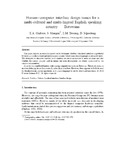| dc.contributor.author | Onibere, E.A. | |
| dc.contributor.author | Morgan, S. | |
| dc.contributor.author | Busang, E.M. | |
| dc.contributor.author | Mpoeleng, D. | |
| dc.date.accessioned | 2011-09-15T10:22:43Z | |
| dc.date.available | 2011-09-15T10:22:43Z | |
| dc.date.issued | 2001 | |
| dc.identifier.citation | Onibere, E.A. et al (2001) Human–computer interface design issues for a multi-cultural and multi-lingual English speaking country — Botswana, Interacting with Computers, Vol. 13, No. 4, pp. 497–512 | en_US |
| dc.identifier.issn | 0953-5438 | |
| dc.identifier.uri | http://hdl.handle.net/10311/887 | |
| dc.description.abstract | This paper reports on research carried out to determine whether a localised interface is preferred by users in a multi-cultural and multi-lingual country where a non-local language is nationally used,.
We attempted to discover whether local symbols are more acceptable to users as icons and also whether the current phrases used in menus and icon descriptions are clearly understood by the
various communities.
A survey was conducted nation-wide among computer end-users in Botswana. The results indicate
an overwhelming desire from users for a localised interface. However, there appears to be little need for localised icons and no agreement as to which language to use for text-based interfaces. | en_US |
| dc.language.iso | en | en_US |
| dc.publisher | Elsevier Science Ltd, www.elsevier.com/locate/intcom | en_US |
| dc.subject | Usability | en_US |
| dc.subject | Culture | en_US |
| dc.subject | Localised interface | en_US |
| dc.subject | Interface design | en_US |
| dc.title | Human–computer interface design issues for a multi-cultural and multi-lingual English speaking country — Botswana | en_US |
| dc.type | Published Article | en_US |
| dc.link | http://www.sciencedirect.com/science?_ob=MiamiImageURL&_cid=271616&_user=778200&_pii=S0953543800000527&_check=y&_origin=gateway&_coverDate=01-Apr-2001&view=c&wchp=dGLzVlt-zSkWz&md5=6fd04542db33567e60555e4066afca06/1-s2.0-S0953543800000527-main.pdf | en_US |

